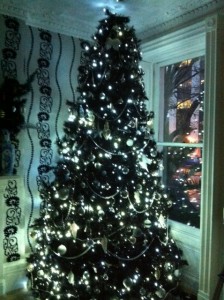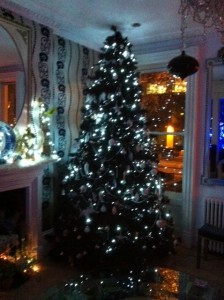The ancient roots of our seasonal delights
I travelled back from New York last Wednesday night. The city was basking in a golden sunshine of late autumn and temperatures in the high 60’s (18 Celsius) – the USA still happily addicted to the scale of Fahrenheit whilst the rest of the word embraces degrees centigrade.
By the time I got on my flight to London City Airport the Big Apple – though still storm tossed and recovering from Hurricane Sandy – was also well into its Happy Holiday season of shopping, eating and celebrating. For Americans I guess the holiday kicks off these days with Thanksgiving and runs on into the early New Year.
In the US as well, as there is Hanukkah amongst other religious festivals at this time of year, the greeting of ‘happy holidays’ is the Universal norm. Not that, it being America, that this genuflection to cultural diversity is entirely uncontroversial. The right wing Evangelical Christians are as usual waging their Canute-like battle with social change – demanding the return of Christmas with the menace of a hostage-taker brandishing a weapon of mass destruction.
Fox news host Bill O\’Reilly rages on from show to show about Christmas being stolen by secular elves and issuing a summons for a crusade to save it from Atheists and other fundamentalists ( which I think is his unthinking code phrase for Muslim). O’Reilly as ever over-reaches the little he knows with the ignorance he displays. The Christmas he thinks we’ve celebrated for 2000 years – since the three Wise Men turned up at the stable in Bethlehem – is in fact an invention of Charles Dickens. It is now pock-marked with outgrowths from the naked commercialism which has in the best evolutionary manner prospered on the fat carcass of this winter feast the Victorians consecrated to the middle-class virtues of family, home and excess.
Over here in Britain Christmas preparations start in earnest for this season of endless eating with the relative austerity of the first Sunday of Advent. It traditionally runs amok through a series of office parties and binge-drinking until it crashes into the hangover of New Year’s day.
The famous twelve days remembered in the Christmas carol in fact hark back – like the Herald angels in the famous Victorian carol for which Mendelssohn wrote the music – to an altogether earlier tradition of feasting.
In the Middle Ages Advent was a little Lent. It was a period of fasting lasting four weeks which was followed by a period of twelve days of feasting culminating in the feast of Epiphany on the 6th January when traditionally gifts of sweets such as sugared almonds were exchanged after mass. The medieval Christmas also gave us the gift of the crib. It was an invention of that most medieval of saints Francis of Assisi. Although it was traditional after Epiphany in churches to take down the decorations for Christmas – in fact the crib was left until the feast of Candlemas. This was kept as the feast of the Purification of the Blessed Virgin.
In the Jewish tradition after giving birth a woman could not enter into the Temple. After 40 days – once menstruation resumed and clean blood flowed freely – the mother could enter the temple and be ritually purified with water and prayers by the priests.The Christian practice of churching followed this Jewish religious practice – and it is amongst the ceremonies provided for in the Book of Common Prayer devised by Thomas Cranmer. Again in Jewish ritual practice at the same time the woman was purified it was customary that the first son of any Jewish marriage was simultaneously presented ( both by the father and the mother) to the priests before the tabernacle of the Temple as an offering to God.
This ceremonial presentation was in memory of the Passover when the Angel of the Lord passed over the houses of the Israelite whose doors & lintels were marked by the blood of the lamb they had ritually killed and were eating standing-up in preparation for the Exodus.
The Presentation of Christ in the Temple became one of the great subjects of medieval art. It also became one of the events of the life of Jesus which attracted cult veneration. As a consequence of this popular piety the event features as one of the Joyful mysteries of the Rosary – a devotional prayer similarly associated with the mendicant orders of the thirteenth century only this time the order of St Dominic (the black friars) rather than St Francis ( the grey friars). The Franciscans exist in three main groups – the friars minor, from St Francis’ use of the word fraticelli – little brothers – to describe his followers – hence the Minories in London – secondly, the Capuchin or friars observant -who observe the rule of St Francis more strictly and finally the Franciscans TOR – hermits – aesthetic friars – typified by the hermits in Charterhouse in 1530’s and were executed for treason by Henry VIII.
In the Middle Ages the candles were coloured violet. Everyone in the congregation lit their candle from the paschal candle upon the priest’s speaking of the High Priest Simeon’s famous prayer on taking the Christ-child from Mary – – Nunc Dimittis – upon the words – a Light to the revelation of the Gentiles, and the glory of Thy people Israel.Thus the greater Christmas season stretched essentially from midnight Mass on Christmas Eve until Candlemas on 2nd February.
However, before for the weeks before the Advent Fast commenced there was also a shorter but just as intense a period of celebration which was referred to as Martinmas. The feast of St Martin of Tours was extremely important in medieval Europe. The picture above is from a German celebration in the 1950’s.
Martinmas is still used as the name of one of the Law Courts Terms in Scotland as Michaelmas is used in England. It was kept of 11th November and it is that feast which is associated with Bonfires which were later backdated by Act of Parliament in England to be used on 5th November for Guy Fawkes celebrations. Thus the bonfire and fireworks and such are nothing to do with Halloween or All Souls.
Martinmas was the occasion in medieval Europe for the slaughter of cattle, pigs and other domestic animals who could not be fed in the relative dearth of the coming winter. The meats were spiced and salted or cured in other ways. Christmas beef – meat preserved with spices that included cinnamon; allspice; cloves; vinegar and salt – was made on Martinmas. It is also the origin of the spiced meat minced and used in the famous Christmas mincemeat.
Like so much in Victorian Britain the spiced meat was replaced with cheap sugar from the slave plantations in the West Indies to make the popular mince-pie we eat today. In Ireland spiced beef is still served at Christmas and can be readily bought in the English Market in Cork. delicacies such as corned beef, silverside, boiled beef and of course pastrami are all derivatives from Martinmas curing. The bonfires were a byproduct of butchery used to burn excess fat. They became a universal accompaniment to the short season of feasting – for this was the last time uncured meat could be readily consumed. Christmas ales were also made at Martinmas whilst ale made from Lammastide was drunk over the feast roasted hogs and beef.
But all these medieval practices looked backed to even earlier rituals around the winter solstice. Yule was a German feast of the Hunting God. To tempt Jul to honour the winter festival within the home greenery and such were cut down from the forests and houses decorated with holly, ivy and boughs of greenery so the god would feel at home surrounded by familiar forests sights. It was again a period associated with winter food preparations: slaughter of domestic animals and feasting from the glut as well as curing and salting meat. It was a period associated with fires and bonfires. There was present giving – often in the form of food exchange. With feasting and drinking and carousing came singing and dancing. These re-emerge in medieval caroling of Christmas and of course the country dancing associated with the twelve days of Christmas.
Though Yuletide lasted from mid-November until January the boughs were not taken from the house and burned until early February – upon the new moon. The pagans kept this as the feast of Imbolc which was itself later associated in Ireland with St Brigitte’s day – another time for burning the remains of the yule decorations and lighting candles to welcome spring. In southern Germany the remains if the pagan festival of Yule runs into the pre lent carnival and is known as Fasching. It embraces the entire period from mid November to Mardi Gras and is still observed as a time for revelry, singing, drinking and eating to excess and also of wild dance.
Below are the words of Simeon’s prayer or canticle or song . There are only three such songs in the New Testament the Magnificat (Mary’s song) Zechariah’s song (Benedictus) and the Nunc dimittis– though the Old Testament is replete with canticles- not least David’s Pslams and the Songs of Solomon. These ancient art forms are commonly found in the works of Homer and other classical authors.
Nunc dimittis servum tuum, Domine, secundum verbum tuum in pace: Quia viderunt oculi mei salutare tuum Quod parasti ante faciem omnium populorum: Lumen ad revelationem gentium, et gloriam plebis tuae Israel. Now Thou dost dismiss Thy servant, O Lord, according to Thy word in peace; Because my eyes have seen Thy salvation, Which Thou hast prepared before the face of all peoples: A light to the revelation of the Gentiles, and the glory of Thy people Israel. And here the most famous of the advent carols – O come, o come emmanuel The First Carol of the Season – in Gaelic


Pingback: From Gaudete – Advent adventures to the fourth sunday | John Murphy